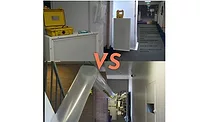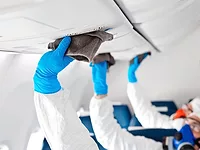Infection Prevention in Medical Environments: The Contractor’s Role
It is important that workers see their role as part of the prevention, care and treatment rather than only as performing the duties of their trade in a “special” environment








No matter the reason, healthcare projects have become a constant. And while any project in an occupied building can be an inconvenience to those in the building, activities conducted in an occupied healthcare (HC) environment can present significant risk to patients. These activities can also impact the ability of staff to provide care and treatment to their patients.
The impact of construction on the ability to provide care can take on many forms. Some types of mold spores can cause infections in some patients and these spores can become airborne during construction activities. Increased noise levels can adversely impact patient populations, such as a newborn infant in a Neonatal Intensive Care Unit. Vibrations impacting water systems could disturb previously stable biofilms, potentially releasing legionella bacteria into the environment. For these reasons, it is important that workers see their role as part of the prevention, care and treatment rather than only as performing the duties of their trade in a “special” environment.
What do you Mean I am Part of the Clinical Team?
Whether it is abatement, demolition or construction, the trades need to understand the broader scope of the risks their work activities may present when working in an occupied HC environment and the key role the contractor can play in communicating and managing those risks.
Failure to properly recognize and manage these risks could result in adverse outcomes, ranging from project delays to far more serious situations such as patient injury or illness. Numerous articles that have been published identify a direct link between poorly managed projects and infections. For these reasons and others, risks to patients and staff that can be introduced during such activities need to be identified early and managed for the duration of the project. Proper management of environmental risks during construction can achieve the primary goal of preventing injury, infection or illness to patients. It can also ensure compliance with regulatory standards and any in-house policies and procedures that are in place. Understanding the processes and playing an active role in the mitigation of environmental risks during construction can make the contractor a valuable part of the hospital team.
Guidelines, Standards and Good Ideas
The management of these risks starts with first recognizing which risks are present. The Association for Professional in Infection Control and Epidemiology (APIC), the Centers for Disease Control and Prevention (CDC) and others have detailed a process called the Infection Control Risk Assessment (ICRA). This process calls for a pre-project assessment conducted by a multi-disciplinary team. The team should represent knowledge of a broad variety of skill sets including infection control, project scope, clinical considerations in the impacted departments and how the building’s systems function. Others may also be needed for the risk assessment process to identify control measures and assist with environmental monitoring and sampling methods as well as interpretation of data.
The Joint Commission (TJC) is an independent, not-for-profit organization that certifies more than 20,000 health care organizations and programs in the United States. TJC provides us with an Environment of Care (EOC) Standard that also calls for a pre-project risk assessment (PCRA). The EOC standard directs the owner to consider the project’s impact on infection control, air quality, noise, vibration, utilities and the ability to provide care, treatment and services under normal and emergency situations.
Noise, vibration, impact to utilities and disruptions to work flow can often be identified as risks to the indoor HC environment during construction and need to be considered during the risk assessment. However the most commonly identified risk is impact on air quality. Therefore, the most common risk mitigation measures (RMM’s) implemented by contractors are those associated with controlling airborne hazards such as dust, fibers, odors or spores. These measures commonly include installation of work area containments, establishing negative pressure in the work area using portable HEPA-filtered air scrubber units, placing sticky mats at the entry to the work area, use of disposable coveralls and other special work practices.
Some Familiar Steps… With a Twist
The use of containment barriers and placing the work area under negative pressure is not new in the remediation world. However, there are a few additional concerns that must be considered when using these in HC settings. For example, the HC setting can be highly engineered with some rooms designed to function under negative pressure, such as Airborne Infection Isolation Rooms (AIIR). Other rooms may be engineered to function under positive pressure such as Protective Environment (PE) rooms or Operating Rooms (OR’s).
Pulling air from one zone could pull air from other areas and change the pressure relationships, potentially causing areas to fail to meet the clinical design needs. This can happen if the air is exhausted outdoors or even more so if exhausted indoors. Therefore, the team may be required to provide input regarding the amount of air to be removed from the work area, exhaust locations, which finishes will be removed and when, if the work is impacting above ceiling spaces and other considerations that could impact the air balances in the building.
So you Think it’s Controlled… Prove It!
Once the control measures have been selected, the methods for monitoring the effectiveness of those measures must also be discussed. Testing the environment inside and outside the work area during work activities and to demonstrate that the work area is ready for re-occupancy is also not new to the remediation and restoration community. Once again, asbestos is a good model to illustrate the concepts. However where asbestos has regulatory limits that can be used to determine acceptable levels, measuring dust particles does not, so some controls testing may not be necessary if well established procedures have been found to be effective and those procedures are followed.
One example of this might be to flush a plumbing system with superheated water to stabilize the system prior to occupancy rather than sampling the system for pathogens. It should be understood that the decision of how and when to test, or to use and document procedures rather than test, is made by the qualified risk assessment (RA) team.
These are examples of testing methods for post-construction/pre-occupancy discussions, often referred to as “clearance testing.” These pre-occupancy test methods may also be part of a system commissioning process. However, testing prior to and during the project may also be valuable to the project. If the RA team has determined that a negative pressure work area is needed and that concerns about impact of dust and pressure differentials on the adjacent spaces are still concerns, then a monitoring plan that will best prove the controls are effective should be developed.
Why would we be concerned about the impact of dust outside the work area if we had effective containment under negative pressure? First, testing can be used to prove what we suspect is happening, that the control measures selected are effective. Second, vibration from the project may disturb dust outside the work area. And third, monitoring can help build confidence between the project team and the clinical side of the house.
To provide context for data collected during construction, it may be necessary to assess pre-project conditions, which are sometimes called baseline data collection. For example, to determine if the project is causing elevated dust levels outside the work area the typical levels of dust found in and around the proposed work area prior to construction activities may need to be known. One possible approach is to establish test locations that will be used during construction. These locations should include the areas where the potential for migration from the work area are highest, such as at the entry/exit to the area. For the purposes of this discussion, these are identified as critical control locations. Additional valuable test locations can include indoor control areas. These are areas where the RA Team agree would be typical of indoor activity with little or no possible impact from the project area. Indoor control locations are even more valuable if they are served by the same air handling unit (AHU) as that of the critical control locations and with similar occupancy and use. If indoor control locations on the same AHU are not feasible, then finding indoor locations with similar occupancy and use that are served by a similar AHU would be a good second option. Indoor dust levels can vary greatly during the course of a day and be impacted by myriad activities. Limiting variables in the indoor environment helps make the data easier to interpret. Using locations services by AHU’s that have the same outdoor air intakes and similar filtration, and with similar indoor occupancy and activities, limits the variability present.
Once test locations have been selected, data can be gathered using a number of methods. One method becoming more common is to use particle counters. These handheld devices read particles in air. These can be useful for comparison testing. They can count the number of particles and differentiate particle sizes. They do not differentiate what the particle is. While they can tell you how many particles per cubic meter of air are present at a location, they cannot tell you if the particles present are spores, skin fragments or cotton fibers.
Testing pressure differential conditions follows a similar process. Identify critical control locations, other areas of concerns and indoor control locations. Testing pressure differentials may be as easy as using visual methods, such as releasing a powder or ventilation “smoke” test and watching the direction of flow, or using a thin tissue or “flutter strip” and seeing the direction it is pulled when placed at the edge of a door or window. If quantitative data is needed, handheld instruments called micromanaometers can be used. When using a micromanometer, a hose is placed on one side of the barrier (e.g. door or window) while the inspector stands on the other side. The device reports the differential pressure in real time.
These are just some of the methods that can be used to monitor the effectiveness of controls. The RA team has the duty to consider the risks, select controls when risks are identified and ensure proper evaluations of the controls are performed.
Prevention is the ROI
If risks are not identified and managed, the construction project can have a direct impact on patients and the ability of staff to provide care and treatment. If the project does not properly manage the risks, the owner could face fines or worse. Lawsuits naming the owner and construction project teams are becoming more common, and without conducting the appropriate actions and compiling proper documentation, the cost of defending against these claims can increase dramatically. However if the ICRA/PCRA process is followed, then these adverse outcomes can be avoided. If a well qualified risk assessment team is assembled early in the project, if the scope of the project is well understood, if the right questions are asked and answered, if the risk mitigation measures are appropriately selected and implemented, if the effectiveness of those measures are proven through appropriate testing and all steps are well documented, then the risks to patients and staff can be reduced or eliminated. As a bonus, the project achieves compliance with standards.
From the very beginning of the project, the contractor can provide key input regarding methods that will be used, the noise that can be expected, negative air exhaust locations and chemicals to be used. This essential input can help identify the measures needed to manage the risks. This information can also help guide the team in the selection of testing methods, locations and schedules. Knowing the impact of activities on the environment, implementing control measures and being an active participant in the risk management process can allow the contractor to become an effective participant in preventing illness and an assistant in the delivery of care and treatment.
Looking for a reprint of this article?
From high-res PDFs to custom plaques, order your copy today!












